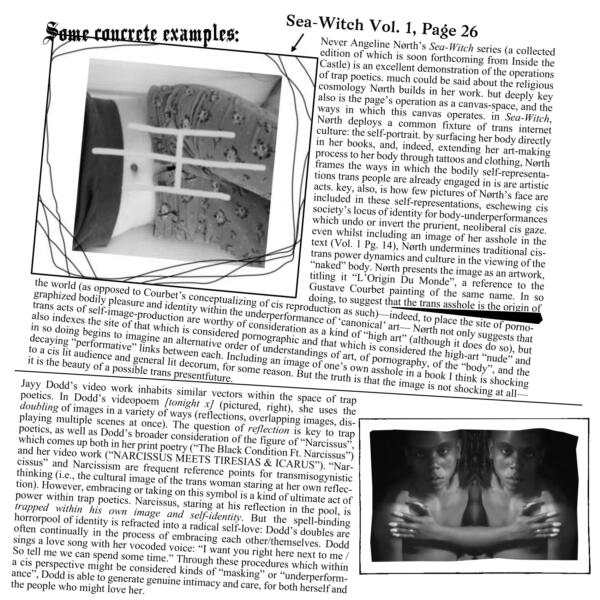“Trap Poetics” [Part 1] [Part 2]

Accessibility Text
This page consists of a more linear text with accompanying pictures, which will be described as they are encountered. The text is tilted in various ways in order to appear crooked.
Some concrete examples:
There is a picture from page 26 of Never Angeline Nørth’s “Sea-Witch Volume 1”. The photo is an image of Nørth’s stomach and upper legs in a lying down position with an abstract glyph layered on top of it.
Never Angeline Nørth’s “Sea-Witch” series (a collected edition of which is soon forthcoming from Inside the Castle) is an excellent demonstration of the operations of trap oetics. Much could be said about the religious cosmology Nørth builds in her work, but deeply key is the page’s operation as a canvas-space and the ways in which this canvas operates. In “Sea Witch,” Nørth deploys a common fixture of trans internet culture: the self-portrait. By surfacing her body directly in her books, and, indeed, extending her art-making process to her body through tattoos and clothing, Nørth frames the ways in which the bodily self-representations trans people are already engaged in are artistic acts. Key, also is how few pictures of Nørth’s face are included in these self-representations, eschewing cis society’s locus of identity for body-underperformances which undo or invert the prurient, neoliberal cis gaze. even whilst including an image of her asshole in the text (Vol. 1 Page 14), Nørth undermines traditional cis-trans power dynamics and culture in the viewing of the “naked” body. Nørth’s presents the image as an artwork, titling it “L’Origin Du Monde”, a reference to the Gustave Courbet painting of the same name. In so doing, to suggest that the trans asshole is the origin of the world (as opposed to Courbet’s conceptualizing of cis reproduction as such)—indeed, to place the site of pornographized bodily pleasure and identity within the underperformance of ‘canonical’ art—Nørth not only suggest that trans acts of self-image-production are worthy of consideration as a kind of “high art” (although it does do so), but also indexes the site of that which is considered pornographic and that which is considered the high are “hude” and in so doing begins to imagine an alternative order of understandings of art, of pornography, of the “body”, and the decaying “performative” links between each. Including an image of one’s own asshole in a book I think is shocking to a cis lit audience and general lit decorum, for some reason. But the truth is that the image is not shocking at all—it is the beauty of a possible trans presentfuture.
There is a picture that is a still from one of Jay Dodd’s videopoems, titled “[tonight x]”. The image is mirrored so that it appears as if there two Jay Dodds in the frame, and that an arm stretches between them to embrace each other.
Jay Dodd’s video work inhabits similar vectors within the space of trap poetics. In Dodd’s videopoem “tonight x” (pictured), she uses the doubling of images in a variety of ways (reflections, overlapping images, displaying multiple scenes at once). The question of reflection is key to trap poetics, as well as Dodd’s broader consideration of the figure of “Narcissus”, which comes up both in her print poetry (“The Black Condition Ft. Narcisssus”) and her video work (“NARCISSUS MEETS TIRESIAS & ICARUS”). “Narcissus” and Narcissism are frequent reference points for transmisogynistic thinking (i.e., the cultural image of the trans woman staring at her own reflection). However, embracing or taking on this symbol is a kind of ultimate act of power within trap poetics. Narcissus, staring at his reflection in the pool, is trapped within his own image and self-identity. But the spell-binding horrorpool of identity is reflected into a radical self-love: Dodd’s doubles are often continually in the process of embracing each other/themselves. Dodd sings a love song with her vocoded voice: “I want you right here next to be / So tell me we can spend some time.” Through tese procedure which within a cis perspective might be considered kinds of “masking” or “underperformance”, Dodd is able to generate genuine intimacy and care, for both herself and the people who might love her.
Originally from Oxford, Ohio, Ava Hofmann is a trans writer currently living and working in Baton Rouge, Louisiana. She has poems published in or forthcoming from Black Warrior Review, Fence, Anomaly, Best American Experimental Writing 2020, The Fanzine, Datableed, Peachmag, Always Crashing, Foglifter, and Petrichor. Her poetry deals with trans/queer identity, Marxism, and the frustrated desire inherent to encounters with the archive. Her chapbook, THE WOMAN FACTORY is forthcoming from The Operating System. Her website is www.nothnx.com and her twitter is @st_somatic